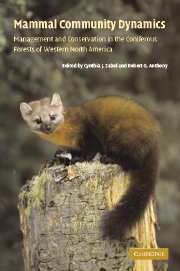 Mammal Community Dynamics
Mammal Community Dynamics Published online by Cambridge University Press: 15 December 2009
Until the late 1970s, biologists tended to deal with one species at a time in terms of consideration in forest management. By that time, the consequences and requirements of the plethora of environmental laws passed during that decade (and the regulations issued pursuant to those laws) were coming to bear through land-use planning and court actions.
Managers and biologists were suddenly faced with having to broaden their considerations to include the entire spectrum of wildlife species in both planning and management. One phase in the planning regulations developed by the US Forest Service to be responsive to the cumulative requirements of the National Environmental Policy Act, The Endangered Species Act, and the National Forest Management Act was to play a critical role in changing biologists' focus and activities. Those regulations required that “ … viable populations of all native and desirable non-native vertebrates be maintained within the planning area.” And, as a result, the world of forest managers and biologists was forever changed.
The first try at summarizing information on the relationship of the entire spectrum of wildlife species to forest habitats was developed in 1976 and published in 1979 (Thomas 1979). It was specific to the Blue Mountains of Oregon and Washington and was based on published information and expert opinion. At the time, the balance was tilted more toward expert opinion relative to hard data.
That effort was quickly emulated for a number of ecosystems in the United States and elsewhere in the world.
To save this book to your Kindle, first ensure [email protected] is added to your Approved Personal Document E-mail List under your Personal Document Settings on the Manage Your Content and Devices page of your Amazon account. Then enter the ‘name’ part of your Kindle email address below. Find out more about saving to your Kindle.
Note you can select to save to either the @free.kindle.com or @kindle.com variations. ‘@free.kindle.com’ emails are free but can only be saved to your device when it is connected to wi-fi. ‘@kindle.com’ emails can be delivered even when you are not connected to wi-fi, but note that service fees apply.
Find out more about the Kindle Personal Document Service.
To save content items to your account, please confirm that you agree to abide by our usage policies. If this is the first time you use this feature, you will be asked to authorise Cambridge Core to connect with your account. Find out more about saving content to Dropbox.
To save content items to your account, please confirm that you agree to abide by our usage policies. If this is the first time you use this feature, you will be asked to authorise Cambridge Core to connect with your account. Find out more about saving content to Google Drive.